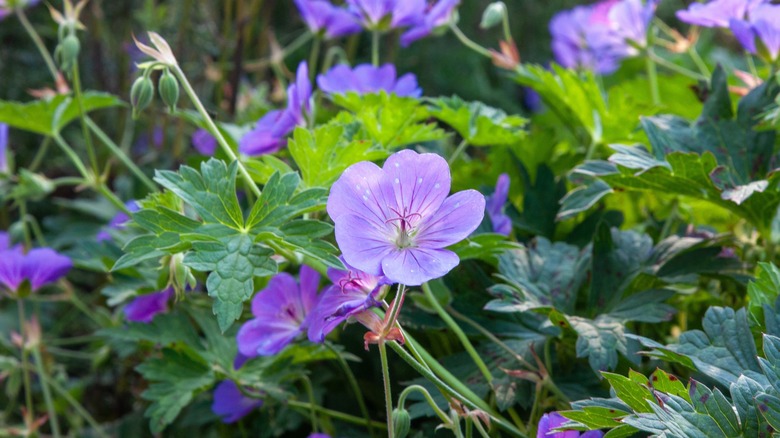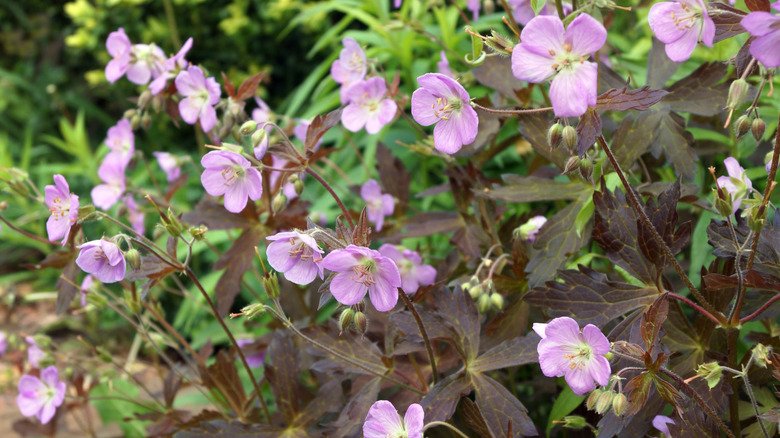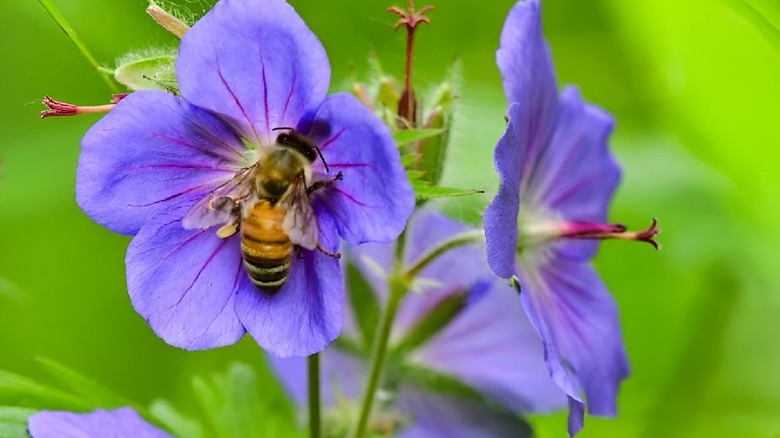How To Grow Wild Geraniums As A Flowering Ground Cover Hummingbirds Love
If you have a woodland garden and you're looking for an easy-to-grow flowering ground cover that'll attract hummingbirds and pollinators to your yard, you'll love growing wild geraniums. These pretty native perennials will fill your yard with masses of showy, nectar-rich blooms in spring and summer. You'll find different varieties with flowers in white, pink, red, purple, and blue. This is one species that you want to plant en masse so the bright blooms can easily be found by visiting hummers.
Wild geranium (Geranium maculatum) can be grown in USDA hardiness zones 3 through 11, making it suitable for many gardeners who are keen to create diverse wildlife habitats in their own yards. This lovely clumping plant only reaches a height of up to 2 feet and will cover the ground with its attractive lobed leaves. It can easily spread through your yard thanks to the seeds that it produces between May and July, but this can be controlled by pulling up any seedlings that pop up in areas where you don't want them to grow. An interesting fact to consider is that the ripe seeds can travel up to 30 feet from the parent plant when they're expelled from the seed capsule. It's also good to know that this species, although it can naturalize under ideal conditions, never becomes invasive.
Ideal growing conditions for wild geraniums
Wild geraniums grow naturally in deciduous woodland areas around the United States. They can be grown in partially shady spots and are perfect for planting under tall trees that will let dappled sunlight through. They can also grow well in sunnier places as long as you give them plenty of water during hotter weather. Being a natural forest dweller, Geranium maculatum does prefer soils that are rich in organic matter and stay fairly moist — the soil beneath deciduous trees is ideal because it will be enriched by the leaf litter that accumulates when the trees drop their leaves in the fall.
Apart from giving your wild geraniums enough water in the summer, these plants don't really require any special care. So, even if you're only just beginning your gardening journey, you can create an impressive display by planting a few different cultivars together for a mass of color. In fact, this is one of those good alternatives for temperamental hostas that you might have found difficult to grow. Popular cultivars include 'Album' which has pretty white blossoms, 'Elizabeth Ann' with bronze foliage and blue flowers, and 'Espresso' which has reddish leaves with attractive pink blooms. There's no need to deadhead these as most species don't normally flower repeatedly, although newer cultivars, like 'Espresso,' may rebloom through summer. You can also cut back the stems a little after blooming to retain a more compact shape.
Benefits of growing wild geraniums in your garden
Besides being super easy to grow and creating a lovely colorful display in your spring and summer garden, wild geraniums offer a feast for all types of pollinators. Bees are particularly attracted to this species, including honeybees, bumblebees, and solitary bees. You'll also find that syrphid flies, ants, and beetles will enjoy visiting the vibrant blooms.
Although the flowers are cup-shaped and not tubular, they're filled to the brim with sweet nectar which is why hummingbirds will love them. What you may or may not know is that these busy little birds feast on insects like ants, aphids, beetles, and flies as well. This means that any plant that attracts these little bugs is beneficial when you want to lure hummers to your yard. As a bonus, the seeds of Geranium maculatum will also entice songbirds, with mourning doves and bobwhite quail being especially fond of the tasty morsels. And, while you're looking for ways to make your yard more wildlife-friendly, you might also be interested in some genius tips and tricks to attract more hummingbirds to your garden.


